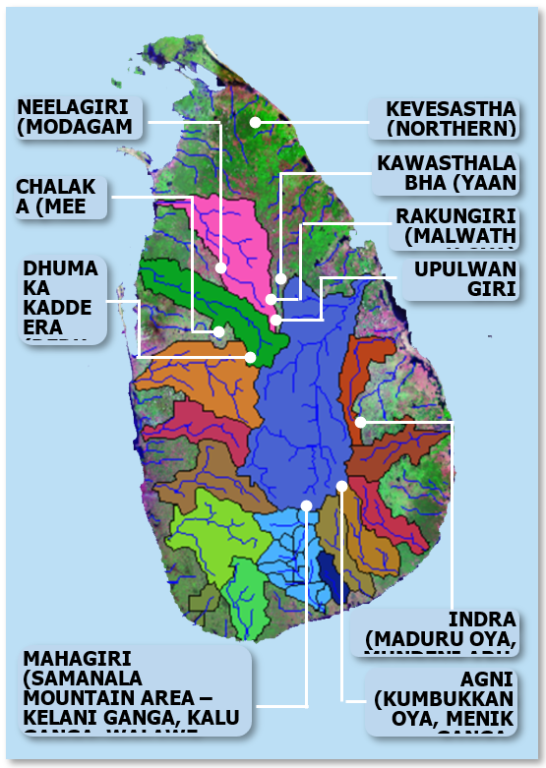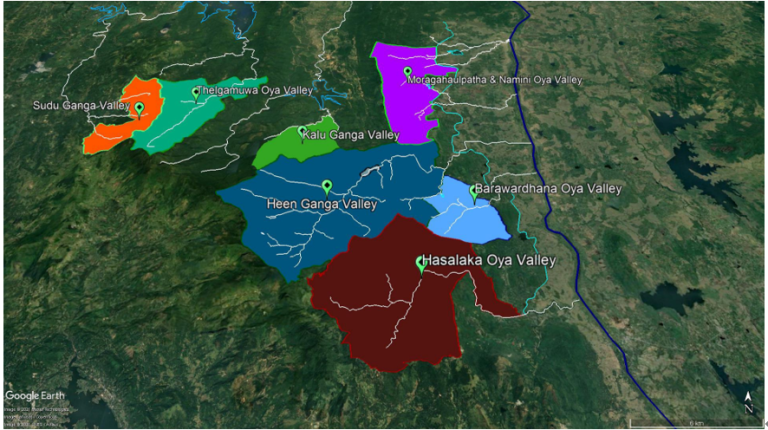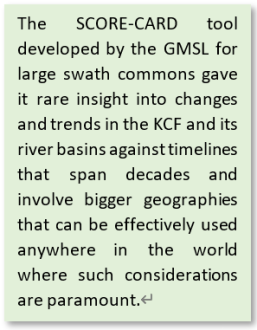Innovative approaches of the GMSL to harmonize the Human-Environment Interface (HEI) in the Knuckles Conservation Forest (KCF) and its environs
30.07.2023
SUBMITTING ORGANIZATION
Green Movement of Sri Lanka Inc.
DATE OF SUBMISSION
14/05/2023
REGION
Asia
COUNTRY
Sri Lanka
KEYWORDS
Innovation in harmonizing the human-environment interface, amalgamating traditional knowledge with modern science, re-lensing of concept of community and concept of rights
AUTHORS and AFFILIATIONS
Arjuna Seneviratne, Chief Technical Advisor, Green Movement of Sri Lanka Inc.
WEB LINKS
Summary Sheet
The summary sheet for this case study is available here.
Introduction:
This case study is based on an inception research study created by the GMSL targeting the Knuckles Conservation Forest (KCF) and its environs as part of the Community Livelihood and Biodiversity Improvement (COLIBRI) project funded by the European Union. During the course of the study, the research team of the GMSL led by its Chief Technical Advisor and anthropologist Arjuna Seneviratne and supported by the CEO of the GMSL Suranjan Kodituwakku as well as an agriculturist, environmentalist and hydrologist identified unique techniques for approaching the harmonization of the Human-Environment Interface (HEI) in the KCF. The GMSL subsequently redesigned its initial programming factoring in the inputs from the outcome report of the research study. This case study outlines the approaches taken and the outcomes of the two-year effort that ended in April 2023.
Unique approaches taken:
Use of ancient societal traditions in water management to treat the KCF through a river basin approach:
Despite there being no historical evidence of the existence of humankind in Sri Lanka before Vijaya 2,500 years ago, citizens traditionally believed there was human habitation in Sri Lanka much before that and much of that pre-Vijaya history revolved around a King called Ravana (Apparently 2554-2517 BC) and his immediate ancestors. This alternative history is mentioned by Dharmasena (2017) in outlining traditional knowledge in adapting to climate change and is affirmed through a KPI with Mr. Jayatissa of Matale. According to them, at its zenith, Sri Lanka’s holistic farming methods defaulted to optimizing natural resource use (primarily land and water) and human productivity by establishing their communities along the banks of the 103 rivers and the natural and artificial tanks and reservoirs that were built from time to time. The entire food production method was therefore centered on the waterbodies as they were across the great ancient civilizations of the world such as the Fertile Crescent (Tigris, Euphrates, and Nile rivers), Indus, Yangtze civilizations etc. The argument was simply that optimizing the quality, availability and use of water resulted directly in optimizing the health and agricultural production of a country and in order to optimize the water, there was a need to optimize the environment. This was the primary reason why the ancients never touched the upper watershed of the central hills of Sri Lanka nor allowed people to populate it.

As seen in map 01, the ancient rulers of the country were extremely cognizant of the dynamics of the geophysical, geospatial and hydrological phenomena of the country and the importance of working in harmony with it instead of against it. It is because of this very reason that our irrigation and water management systems of yore are still considered to be a marvel that no modern engineer has ever been able to either emulate or replicate. It must be duly noted though that anthropogenic activities of the last 70 years such as accelerated development projects as well as population migration to untouchable areas such as watersheds made the task challenging but still doable.
In the KCF, the GMSL was treating that very watershed that has been damaged by anthropogenic activity and development aggression. Therefore, it was logical for the research team to consider the ways of the ancients. They identified the fact that treating a terrain through its administrative boundaries was suboptimal. Analyzing satellite imagery on the layout of traditional and more modern settlements within the KCF, it observed that both human settlements and anthropogenic activity was centered on the basins of the rivers flowing out of the KCF massif as seen in this satellite map. A short video on the initial approach and strategy may be found here. Having identified the approach, the GMSL chose seven river basins, namely, the Heen Ganga, the Kalu Ganga, the Thelgamu Oya, the Sudu Ganga, the Barawardhana Oya, the Namini Oya and the Hasalaka Oya basins for treatment. The key premise here was that nature does not follow human administrative boundaries and if there was to be any sustainability to the effort to harmonize the terrain, it must be done by focusing on the water dynamics and their relevance to all sentient beings living therein.

Innovative method for acquiring data from communities living in and using large swath commons:
Once the GMSL decided to treat entire river basins, the approach to balancing anthropogenic activity that had their own natural orders and dynamics became quite complex. The GMSL team determined that it was vital to drill deep into all communities living in these areas and to do that simultaneously in order to understand the way in which they lived, their upstream-downstream dynamics, their relationship with the conservation forests and the reasons why they are at present using damaging agricultural techniques, engaging in illegal activities within the KCF and in a vicious cycle, becoming poorer and more impoverished.In order to do this, the GMSL created a new data polling tool called Strategic Commons Organization, Regeneration and Enhancement: Community Affirmation of Realities and Dynamics (SCORE-CARD) to confirm through community engagement observations and conclusions obtained through field visits, research and community work.

The tool is for use when considering very large swaths of geography containing many communities that are either disparate or separate through cultural, administrative and social boundaries but who share key commons such as water (ex: a river), natural ecologies, ecosystems or habitats (ex: a large conservation forest area) or combinations thereof. The tool was built to be used by teams that have worked in a given terrain for decades (such as the GMSL who had worked in the KCF for almost a quarter century) but should not be attempted by new entrants into a given terrain, those who wish to use such tools as PRAs and RRAs or wish to ring-fence geographies for treatment. A full exposition of the methods used may be found here. It should be noted however that despite its great advantage over other methods, the analytical components of the tool are not perfect in terms of behavioral predictive analytics and this is an area that the GMSL is working on to rectify.


Re-lensing the concepts of community and rights:
As a crucial break away from mainstream ideas of community, the GMSL recognized that everyone and everything in the KCF constituted its “community” and when lensed in that way, the GMSL used a whole-of-community approach taking the entire cloud as its treatment group – regardless of whether they benefited from the intervention or not. This approach prevented delineation and massively improved its ownership within the community because the effort was seen as something that was advantageous to the plants, the animals, the people and the earth. Most importantly, it also meant that individual profit was organically subsumed in communal gain and gave a real, concrete, “can hold on to” meaning to the phrase “community livelihood, community biodiversity shall both be improved”. The approach also harkens back more than a century to the words of Chief Seattle whose words at on the cover of this case study.

The GMSL recognized that strong social institutions were required to make mainstream rights approaches work. In Sri Lanka however, such is not the case. While Sri Lanka is second to none in healthcare and education, it is significantly lacking in constitutional guarantees, access to and trust in the legal system, access to information, access to and trust in enforcement agencies and regulators and access to finance. Under such circumstances, mainstream lineal/segregated rights become unusable such as is the case when communities are segregated in line with normative cleavages based on rights into such groups as men, women, youth, children and piecemeal treatment of each of those through linear logic creates internal tensions, increases disharmony and destroys the need to cooperate with one another while the rights themselves are comparatively useless because there is no rational for using them when the enabling social institutes are suspect. Most importantly, community rights based on their cultures, their habits and their customs, which are the only usable rights they have are violated leading to confused and broken communities. In order to re-dignify the community, the GMSL created an innovative “7Cs” strategy that is outlined in Diagram 2 at left. Through this effort, the GMSL ensured that nothing and no one was left behind as elaborated in this best practice that is elaborated here.

Reintroducing traditional farming practices to the KCF and its environs:
Having taken its approach based on traditional agro-cultural societal sensibilities, the GMSL research team naturally turned to the ways in which farming was made sustainable in that era and looked at the ways in which the era of kings farmed the country and identified the fact that the food culture inculcated by them was based on three non-negotiable factors:
- Food was nature’s gift and therefore the human-environment interface had to be harmonized
- All citizens had be able eat whatever they want whenever they want (Food Sovereignty)
- Consumption of social, economic and natural resources had to be need based only (Conservation)
The cultivation tradition was based on a grain culture that included a wide variety of grains and millets. The selection of the specific rice varieties to be cultivated was based on the environment, weather and water availability of specific areas with over two thousand rice varieties(Thilakasiri, 2019) known to have been cultivated during that period. During both the low country kingdoms and the Kandyan Kingdoms, fruit, vegetables and medicines were cultivated through methods that mimicked the way in which nature grew plants . In the former, this was through chena cultivation while in the later it was through the Kandyan Home Gardens. Additionally, a significant proportion of foods were uncultivated and either harvested from the area of the settlements, the nearby forests or from plants that grew within homesteads or cultivation plots spontaneously such as some medicinal plants, leaf and root vegetables and even fruit such as mango and jak. The system ensured that there was minimal invasion of natural systems and most importantly, were methods that recognized that nature dominated all and that anything that was done against nature would fail over the distance.

Going by these findings, the GMSL researchers identified that for the lower reaches of the KCF, the traditional chena cultivation method was the most sustainable while for the upper reaches (mountainous areas) the an expanded version of the traditional Kandyan home garden that the GMSL innovated called the Knuckles Life Garden (KLG) was recommended. These were both aimed at significantly increasing food diversity while improving the ecosystem services of the KCF to farmlands through natural management of the interface between farmed areas, buffer zones and forest areas. These methods were subsequently used in the intervention itself with significant success. A full exposition of the findings of the team on ancient farming practices as well as the problems with modern agricultural practices maybe found here.
Conclusion
Subsequent to these innovative approaches and ideas, the GMSL recalibrated its programming and over the next two years, despite the COVID19 in 2020 pandemic and the socioeconomic meltdown of the country in 2022, still implemented one of the most successful projects ever attempted in the KCF and its environs. As with all projects of this nature, there was a healthy mix of unsort for success and unanticipated failure. At its end, the GMSL observed much, learned a lot and taught the communities a little. They only needed to be triggered into action. In May 2022, the GMSL, already at the end of most of its planned intervention under the COLIBRI project, posted this video to mark World Biodiversity Day 2022. It is an honest and complete exposition of the outcomes of the newly identified methods of the GMSL. The GMSL is quietly proud that it managed to amalgamate the ancient wisdom of our ancestors with the great positives of modern science to create and execute a turnkey project within its wider program for the socio-environmental conservation of the vital upper watershed of Sri Lanka.
References
(06 May 2022) Indus Valley Civilization, Drishti IAS Blog, https://www.drishtiias.com/blog/indus-valley-civilisation
Dharmasena, P.B., (2017). Sri Lankan Traditional Knowledge in Adapting to Climate Change, Workshop on Conservation and Utilization of Local Varieties, Traditional Knowledge Associated with Genetic Resources in Agriculture”, Oak Ray Regency Hotel, Kandy.
Fertile Crescent, National Geographic, https://education.nationalgeographic.org/resource/fertile-crescent/
Green Movement of Sri Lanka Inc. (2020), Advantages of traditional farming practices, the evolution to reductionist agriculture and the problems therein, https://gmsl.lk/wp-content/uploads/2023/05/Change-in-food-production-practices.pdf
Green Movement of Sri Lanka Inc. (2022), “Leave No One Behind” – GMSL Best Practice, COLIBRI Project
Huang He Valley, National Geographic, https://education.nationalgeographic.org/resource/huang-he-valley/
Jayatissa, G., Interview, Conducted by Seneviratne, A., 14 February 2020.
Seneviratne, A., 13 May 2023, heen ganga fracturing, https://www.youtube.com/watch?v=xEzEAcB5gCQ
Seneviratne, A., 22 May 2022, World Biodiversity Day 2022 – For a shared future for all life, https://www.youtube.com/watch?v=xD8gN5wu_Q8
Seneviratne, A., 24 March, 2021, Following the Water – COLIBRI GMSL – First observations on the KCF, https://www.youtube.com/watch?v=FQceFOTm4XQ
Seneviratne, A., Wijesinghe, J., Kumaratunga, N., Akila, J., (2020), Inception report for the COLIBRI project.
Seneviratne, A., Wijesinghe, J., Kumaratunga, N., Akila, J., (2020), Score-Card Framework, https://gmsl.lk/wp-content/uploads/2022/11/SCORCARD-FRAMEWORK.pdf

